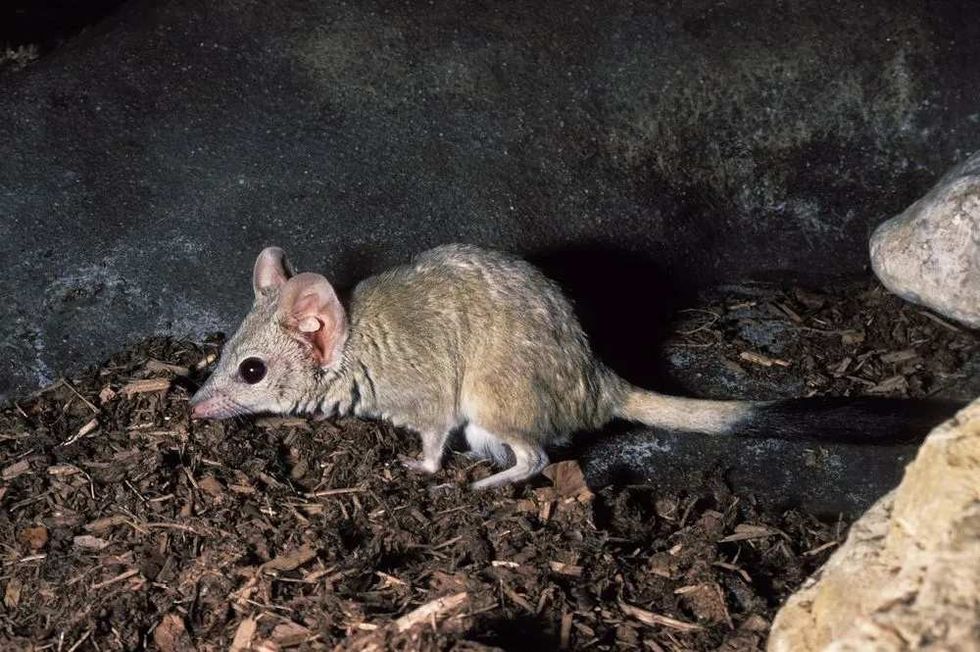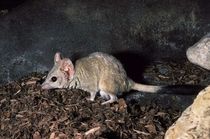Kowari is a species of Australian rat, native to Central Australia. It is also known as a Kawiri, a bushy-tailed marsupial rat, a Byrne's crest tailed marsupial rat, or a brush-tailed marsupial rat.
They inhabit the western part of Queensland, Charlotte Waters, the northeast of South Australia, and the stony desert in the Lake Eyre drainage basin. The preferred habitat of these small animals includes desert, savanna or dry grassland, and gibber plains.
They have a grayish coat on their body with a unique tail. Their tails have an erect black brush on the top and bottom.
They are carnivorous animals and their diet includes snails, lizards, rodents, spiders, and small birds. They live up to six years in captivity.
They breed in the winter from May to December. After mating, the female gives birth to five young Kowaris. However, the clutch size can range from three to seven.
The young are weaned for a span of 95 to 110 days after birth. The International Union for Conservation of Nature has listed Kowari (Dasyuroides byrnei) as Vulnerable. The destruction of habitat and climate change is responsible for the decrease in their population.
If you liked reading this article about Kowaris, then please check out our other articles on the marsupial mole and marsupial for more interesting facts.
Kowari Interesting Facts
What type of animal is a kowari?
Kowari is a species of Australian rat belonging to the Dasyuridae family.
What class of animal does a kowari belong to?
This creature belongs to the class Mammalia.
How many Kowari are there in the world?
The number of individuals present in the world is recorded to be around 5000.
Where does a Kowari live?
Kowaris are found in Central and South Australia. These animals have an uneven distribution of their population in the northern part of the South Australian border, known as Charlotte Waters.
They reside in stony deserts located in the Lake Eyre drainage basin. This species inhabits the western part of Queensland, a state in northeast Australia.
They are also found in the northeastern part of South Australia, which lies between the Simpson Desert and the Diamantina River. They also have a range extending from the desert lands of South Australia to the desert channels located in the state of Queensland.
What is a kowari's habitat?
The preferred habitat of these small Australian rats includes desert, savanna, or dry grasslands. These deserts are semi-arid or arid. These regions have minimum rainfall along with low temperatures, especially in the winter. The rocks and sand present on the desert surface hold very little moisture.
Dry grasslands comprise plants that are closer to the ground. This species also inhabits gibber plains. It comprises stony surfaces on the ground formed of small stones and rocks. Gibber plains are located alongside rivers, mounds, dunes, and dry grasslands.
Who does Kowaris live with?
Kowaris usually live alone or in a group. They are often found in small groups with members of the same species, also known as mischief. These groups share their burrows among themselves.
How long does a kowari live?
The exact lifespan of this Australian kowari in the wild is not known. They can live up to six years in captivity.
How do they reproduce?
Kowaris are monogamous having one partner throughout their lives. They usually breed in the winter. Their breeding season ranges from May to December and reaches a peak in May to July.
The pairs undergo a prolonged mating period of one to three days. Females are usually involved in building the nests during the breeding season. After mating, a female gives birth twice a year.
Their gestation period extends from 30 to 36 days. They usually have a litter of five offspring, but it can range from three to seven offspring. The young, also known as pups, are born deaf and blind. The young are attached to their mother for 30 days after birth.
Females are mostly involved in parental care. The weaning period of the pups extends from 95 to 110 days, after birth. They attain reproductive maturity after seven to nine months.
What is their conservation status?
The International Union for Conservation of Nature has listed Kowari (Dasyuroides byrnei) as Vulnerable. They are vulnerable to the destruction of habitat and climate change.
Kowari Fun Facts
What does Kowaris look like?
A kowari (Dasyuroides byrnei) is a small brush-tailed marsupial rat, that has a grayish coat on its body, with some shades of brown. Males are slightly larger than females. They have a characteristic white belly, pink snout, and ears.
Their feet are lighter in color, with five toes on the hind feet and four toes on the front feet. The gray fade to lighter shades on the tail region.
Their tails have a distinct black brush on the top and bottom. Their unique tail helps in distinguishing the animal from the other members of the genus. They also have a dark band around their eyes.
How cute are they?
Their cuteness usually stems from their appearance and small size. Their pink snout, gray coat, and tail make them attractive.
How do they communicate?
These Australian creatures usually communicate through a range of vocalizations and body language. They usually produce a hissing sound or a screeching chatter when they feel threatened. The movement of tails generally indicates that they are upset.
The pups have a harsh or grating call. They have a scent gland on their chest which they use to scent-mark their territories. They also mark their territories with their feces and urine.
How big is a Kowari?
A kowari has a body length of 5.3-7 in (13.5-18 cm). Their tails are 9.6-12.5 in (24.5-32 cm) long. They are larger than Pilbara ningaui, another species of the family Dasyuridae which is 1.8-2.2 in (4.6-5.7 cm)
How fast can a Kowari run?
A Kowari can run at a speed of 8 mph (13 kph). They usually run to catch their prey like lizards or rodents and to take shelter in their burrow.
How much does a Kowari weigh?
A kowari weighs around 2.4-4.9 oz (70-140 g).
What are the male and female names of the species?
Scientists do not have specific names for male and female Kowaris. They are commonly referred to as male Kowari and female Kowari.
What would you call a baby Kowari?
A baby kowari is usually called a pup.
What do they eat?
A kowari is a small carnivorous creature and its diet includes a variety of invertebrates, like snails and mollusks. The diet also comprises small spiders, lizards, rodents, and birds. They also feed on the eggs of various birds.
Are they dangerous?
They use their sharp incisors to bite or break open barriers. They usually scratch or bite when they feel threatened. Their bites are very painful and can be dangerous to predators or humans. Males often exhibit aggressive behavior towards other males during the breeding season.
Would they make a good pet?
Kowaris can make good pets as they are quite social and intelligent. However, their bites can be painful and dangerous.
Did you know...
A kowari does not drink water. These carnivorous animals receive most of their moisture content or water requirements from their diet.
This animal is known to be a great climber. They can also jump to a height of about 18 in (45 cm) from the ground.
How does the Kowari defend itself?
They usually run and hide inside the burrow or small holes. These are often built on sand. In some cases, they also bite and scratch the opponent or a potential predator. They make use of their sharp incisors to bite or break through any barricade.
What eats kowari?
A few animals like feral or wild cats, dogs, and red foxes prey on Kowaris.
Here at Kidadl, we have carefully created lots of interesting family-friendly animal facts for everyone to discover! Learn more about some other mammals, including Argali or Lowchen.
You can even occupy yourself at home by drawing one on our Kowari coloring pages.










